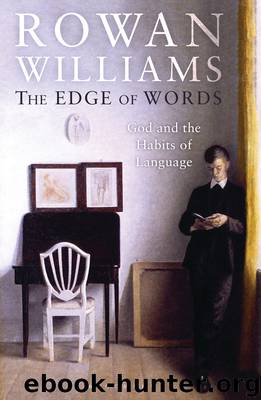The Edge of Words by Rowan Williams

Author:Rowan Williams [Williams, Rowan]
Language: eng
Format: epub
ISBN: 9781472910448
Publisher: Bloomsbury Publishing
2
We are so accustomed to using the rhetoric of ‘dead’ or ‘mindless’ matter that the idea of matter itself as inherently symbolic – in the sense that it is structured as a complex of patterns inviting recognition and constantly generating new combinations of intelligible structures – is likely to seem odd or fanciful. Yet this is the clear implication of the most advanced researches currently conducted on the material world, such as the Human Genome Project. The idea of a fundamental, irreducible description of the ‘real’ stuff of the world, the interaction of basic particles, now seems painfully crude. Several decades ago, David Bohm’s Wholeness and the Implicate Order20 outlined a picture of the ‘material’ world in terms of what he called ‘holomovement’, a connected system in which every local sub-totality of agencies carried the informational content of the whole: we could properly isolate this or that field of agency for analysis when we had identified adequately stable ‘patterns of order and measure’ in a particular locality, but should not forget that this kind of consideration in terms of separable entities is ‘approximate’ and in a sense provisional, given that an adequate mapping of the processes of the universe would need to be one that laid out the way in which the entire cosmic order came to coalesce in this particular way at this particular point – a goal ‘probably unknowable’.21 To speak of an ‘implicate’ order for the universe is to recognize that the whole pattern is folded in to every part: we make distinctions between ensembles of elements as a way of identifying certain situations in which the holomovement crystallizes in such and such a way for a period. The tempting error is to suppose that we have identified enduring and solid building blocks in this making of distinctions.22 It is more helpful, Bohm suggests, to think of the analogy, say, of two photographic images of a fish tank taken from different angles: we see distinct images, with some obvious correlation between them, but we should only understand what was actually being shown when we imagined the three-dimensional medium in which the process was one and undivided. So when we observe correlated behaviour in two atoms at a distance, with no apparent causal connection as we normally understand the term, it is most helpful to think of a further dimensionality in which the observed behaviour was one event.23
Bohm has already, earlier in his book,24 noted that we can be imprisoned by the conventional structures of most of our languages, with their ‘subject–verb–object’ patterns implying that there are fixed substances exerting their agency upon other fixed substances, but the saving eccentricity of language is that it is itself constantly subversive of this pattern. We use language in ways that unsettle the simple notion of basic solid elements, notably by metaphor and other supposedly non-standard forms of utterance. Perhaps, Bohm proposes, we need a quite different mode of speech, or at least of logical representation, which leaves us less enslaved
Download
This site does not store any files on its server. We only index and link to content provided by other sites. Please contact the content providers to delete copyright contents if any and email us, we'll remove relevant links or contents immediately.
Signature in the Cell: DNA and the Evidence for Intelligent Design by Stephen C. Meyer(3075)
The Secret Power of Speaking God's Word by Joyce Meyer(2989)
Real Sex by Lauren F. Winner(2970)
The Holy Spirit by Billy Graham(2896)
The Gnostic Gospels by Pagels Elaine(2473)
Jesus by Paul Johnson(2313)
Devil, The by Almond Philip C(2284)
23:27 by H. L. Roberts(2198)
The Nativity by Geza Vermes(2181)
Chosen by God by R. C. Sproul(2124)
All Things New by John Eldredge(2108)
Angels of God: The Bible, the Church and the Heavenly Hosts by Mike Aquilina(1933)
The Return of the Gods by Erich von Daniken(1899)
Angels by Billy Graham(1889)
Knowing God by J.I. Packer(1809)
Jesus of Nazareth by Joseph Ratzinger(1769)
Evidence of the Afterlife by Jeffrey Long(1746)
The Gnostic Gospel of St. Thomas by Tau Malachi(1739)
How To Be Born Again by Billy Graham(1732)
